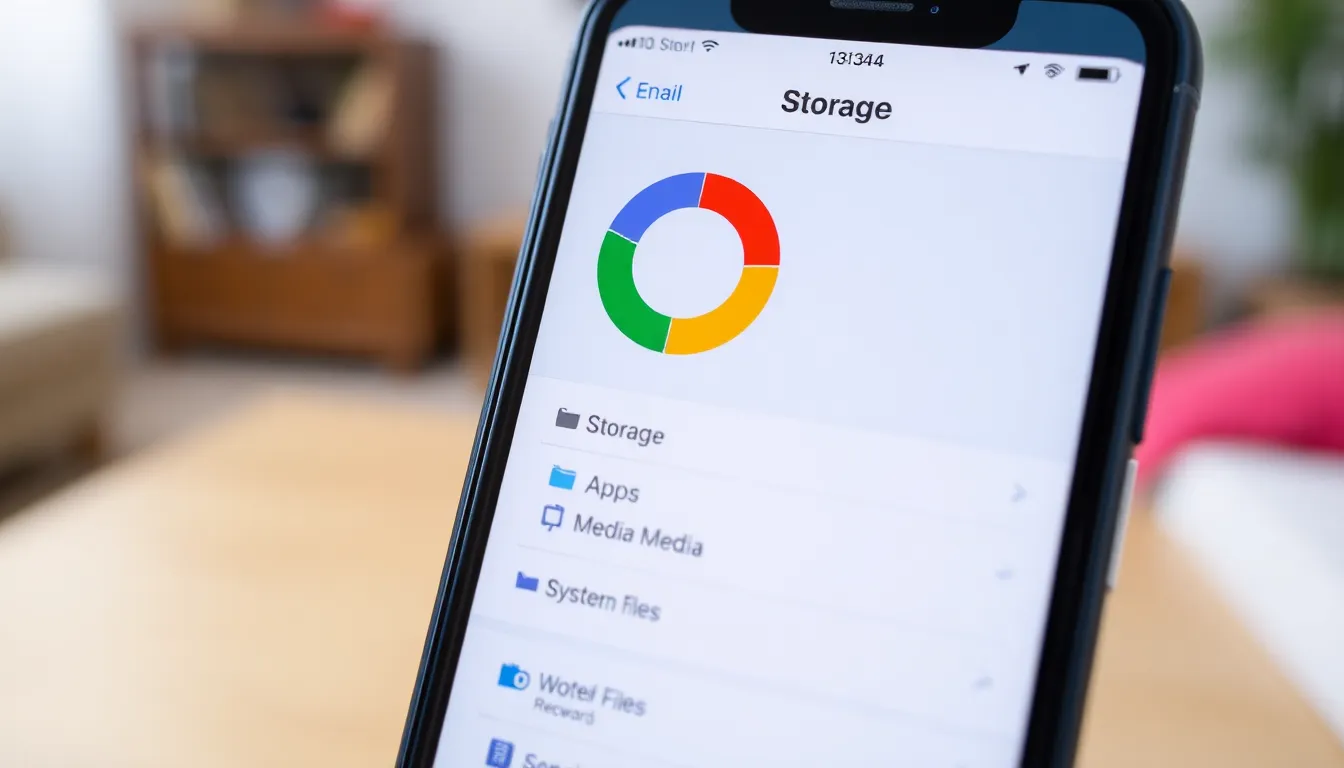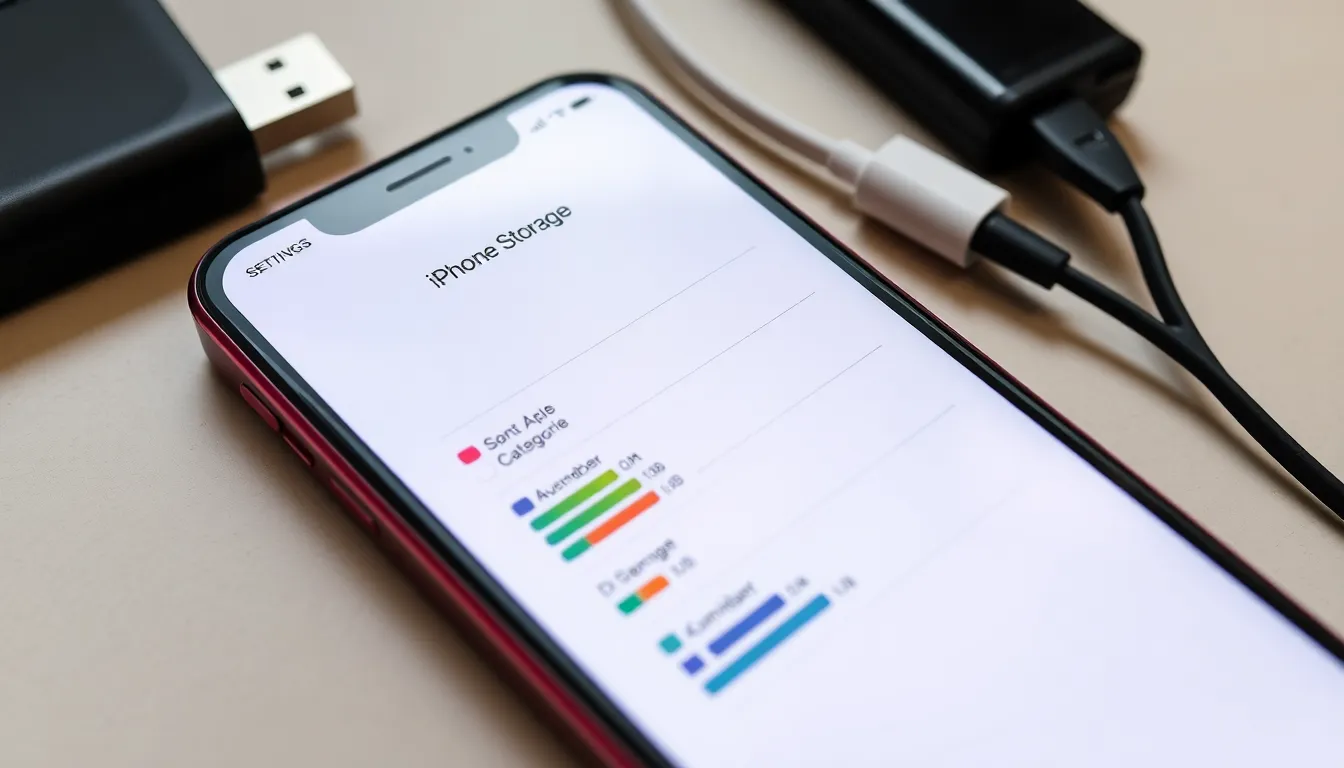Table of Contents
ToggleRunning out of storage on an iPhone feels like trying to fit a giraffe in a Mini Cooper—it’s just not happening. With all those photos, videos, and apps piling up, it’s time to reclaim that precious space. But where do you even start?
Understanding iPhone Storage
iPhone storage consists of various types, each serving distinct purposes. Understanding these types helps users identify where to free up space effectively.
Types of Storage on iPhone
iPhones utilize flash storage, which includes built-in options like 64GB, 128GB, and 256GB. Users often expect to manage their data efficiently within these limits. Cloud storage features, such as iCloud, provide additional options for backing up and storing files remotely. External devices like USB drives also enhance storage capability, allowing transfer of large files away from the device. Compression features in apps can minimize the amount of storage utilized by photos and videos.
How Storage Is Used
Storage on an iPhone gets allocated to numerous categories, affecting overall accessibility. Apps typically consume the most space, as each application holds data and media files specific to its functions. Media files, including photos and videos, similarly take up substantial space due to their high quality and size. System files, which include operating system updates and configurations, occupy a significant portion as well. Messages and attachments, especially those with multimedia, can quickly accumulate and require management. Users must regularly review these categories to optimize available storage.
Finding Your Storage Settings

Accessing your storage settings on an iPhone enables users to monitor and manage available space. This process takes only a few steps, making it straightforward for anyone.
Accessing Storage Information
To check storage availability, users can navigate to Settings. Tapping on “General” reveals a submenu, where “iPhone Storage” appears. This section displays information about total storage and its usage. A visual chart shows app sizes, making it easy for users to identify space hogs. Tapping individual apps provides options to offload or delete them.
Understanding Storage Breakdown
Storage breakdown categorizes usage into apps, media files, system files, and more. Users often notice that apps consume significant space due to large downloads or caches. Media files, such as photos and videos, also contribute substantially to storage consumption. System files can accumulate from updates or background processes. Reviewing each category allows users to pinpoint where most space is allocated, guiding them on efficient decluttering practices.
Managing Your Storage
Managing storage on an iPhone is crucial for smooth operation. Identifying and handling large apps and files plays a significant role in maximizing available space.
Identifying Large Apps and Files
Finding large apps and files starts with navigating to “iPhone Storage” in the Settings. Users see a list ranking apps by their storage usage. Apps like games or streaming services often consume substantial space. Tapping on each app provides insight into documents and data associated with it. Users can decide whether to offload or delete these apps, simplifying their storage management. It’s essential to keep track of media files as well. Photos and videos particularly accumulate quickly, compounded by features like Live Photos. Regularly reviewing these items helps users maintain free space effectively.
Recommendations for Freeing Up Space
Freeing up space involves several straightforward strategies. Offloading unused apps can clear significant storage without losing data related to those apps. Users might also consider deleting large media files or transferring them to a cloud service like iCloud. Managing messages is another area worth attention; users can clear attachments and old conversations that consume space. Creating optimized storage settings for photos, such as using “Optimize iPhone Storage,” reduces burden without sacrificing quality. Additionally, using third-party apps for tracking storage can provide additional insights into space management. Keeping the iPhone tidy ensures optimal functionality and performance.
Utilizing iCloud for Additional Storage
iCloud provides a seamless way to expand storage capacity on iPhones. Users can easily set up iCloud storage to back up essential data, photos, and documents without consuming their device’s space.
Setting Up iCloud Storage
To begin, users should navigate to Settings, then tap on their Apple ID at the top. Selecting “iCloud” opens options for managing storage. Choosing “Manage Storage” allows users to select a suitable plan, starting with 5GB of free storage and going up to 2TB for a monthly fee. After confirming a plan, users can enable iCloud backups by selecting “iCloud Backup” and activating it. This setup ensures that vital information stays protected while freeing up local storage.
Managing iCloud Storage Usage
Monitoring iCloud storage usage proves essential for optimizing space. Users can return to the “Manage Storage” section to review how space is allocated among apps and services. Identifying rarely used files or backups helps in reclaiming storage. Deleting unnecessary data or old backups streamlines storage and enhances device performance. Using the “Optimize iPhone Storage” feature allows photos to remain in low resolution on the device while keeping high-resolution versions safely stored in iCloud. By managing these settings effectively, users ensure that their iPhone operates smoothly while keeping important files accessible.
External Storage Options for iPhone
Finding additional storage options for an iPhone can help users manage their space efficiently. Several alternatives exist for expanding storage capacity.
Compatible External Drives
Many external drives work seamlessly with iPhones, offering quick solutions for extra storage. Lightning connector drives enable direct connectivity, allowing fast data transfers. Popular choices include SanDisk iXpand and RAVPower FileHub, both of which provide reliable performance. Wireless options, such as the WD My Passport Wireless, offer flexibility for accessing files without connecting directly. Users can access and manage files via companion apps, ensuring smooth integration with the iPhone experience. Regularly backing up photos and videos to these drives can help free up internal storage quickly.
Cloud Storage Alternatives
Cloud storage alternatives provide users with a way to expand their storage without physical devices. Services like Google Drive, Dropbox, and Microsoft OneDrive provide user-friendly interfaces for managing files. Each service offers various plans, allowing users to select the right amount of space for their needs. Google Drive, for instance, starts with 15GB of free storage, making it an appealing option. Integration with iPhone apps facilitates easy access to files, enabling collaboration and sharing. Storing important documents and media in the cloud helps users maintain valuable space on their devices.
Managing storage on an iPhone is crucial for optimal performance and user experience. By regularly reviewing storage settings and understanding how space is allocated, users can make informed decisions about what to keep and what to delete. Utilizing built-in features like iCloud and external storage options expands capacity while keeping important files accessible.
Regular decluttering and monitoring of apps and media files can significantly enhance device functionality. With the right strategies in place, users can enjoy a smoother iPhone experience without the frustration of running out of storage.





